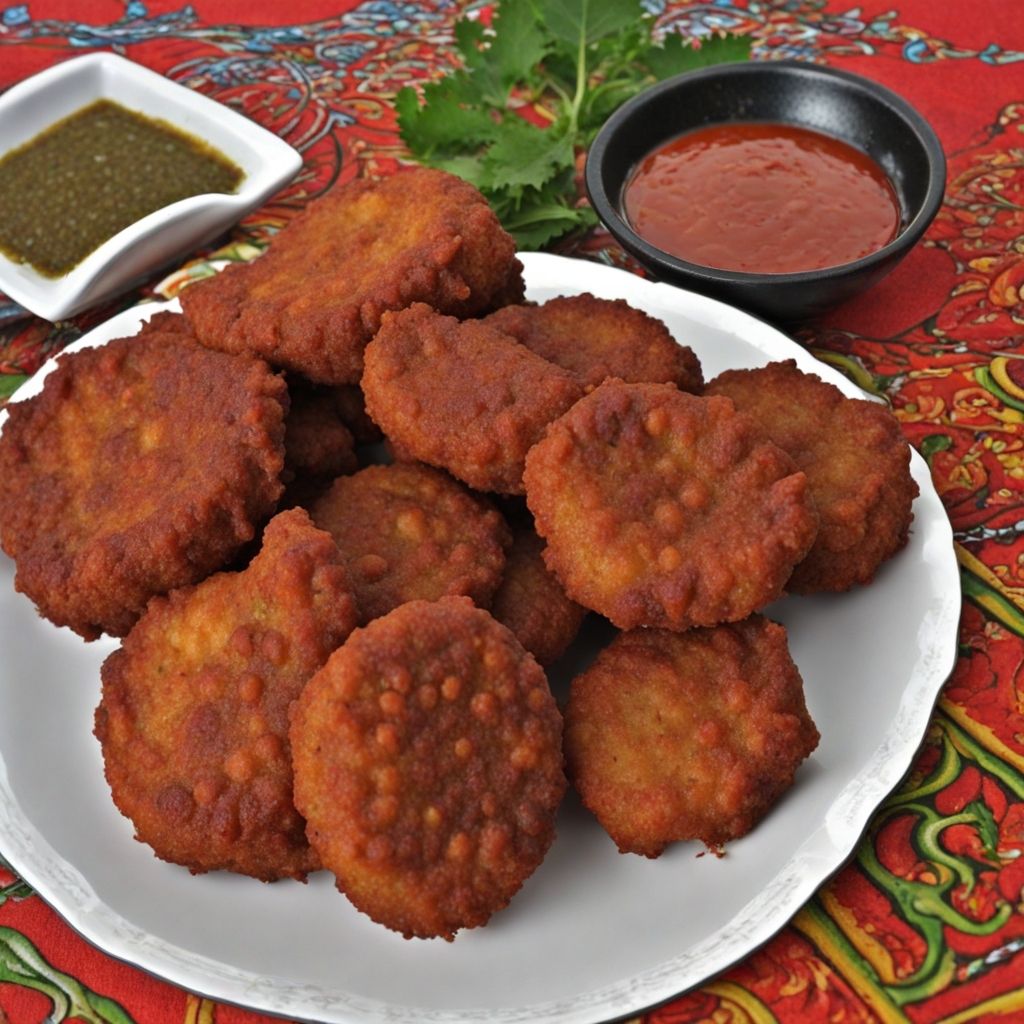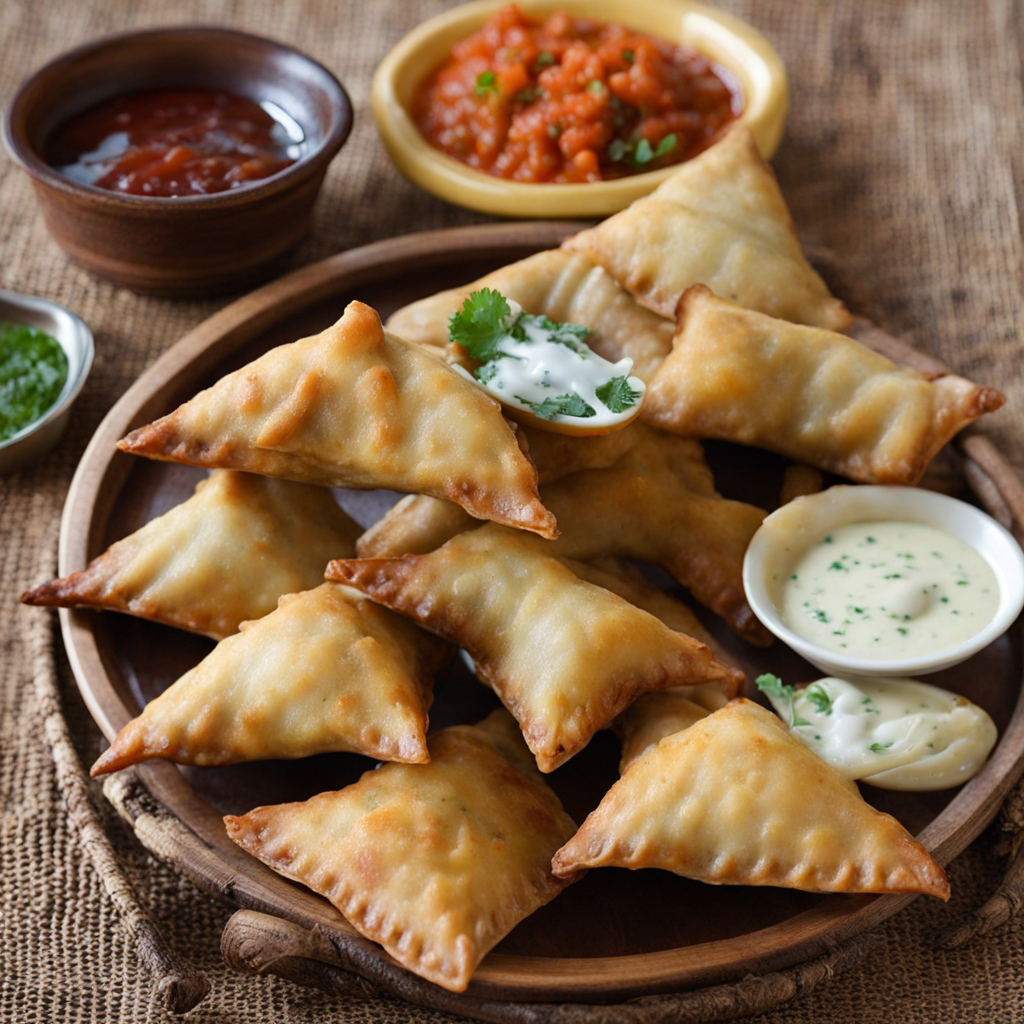Badjias
Badjias are a delightful Mozambican snack that beautifully encapsulate the country's rich culinary heritage. These golden, deep-fried fritters are typically made from a base of chickpea flour, which gives them a unique texture and nutty flavor. Often seasoned with a variety of spices and herbs, such as garlic, onion, and fresh coriander, Badjias deliver a burst of savory goodness in every bite. They can be enjoyed as a standalone snack or paired with a tangy dipping sauce, enhancing their flavor profile and making them an irresistible treat for any food lover. The preparation of Badjias involves mixing the chickpea flour with water to form a thick batter, which is then enriched with finely chopped vegetables and spices. The mixture is carefully spooned into hot oil, where they sizzle and fry to a crispy, golden brown. The outer layer is crunchy, while the inside remains soft and flavorful, providing a delightful contrast in texture. Street vendors often sell these fritters, making them a popular choice for locals and tourists alike looking to experience the authentic taste of Mozambique. Badjias are more than just food; they reflect the communal spirit of Mozambican culture. Often enjoyed during social gatherings or as street food, they bring people together over shared culinary experiences. The combination of spices and the frying process not only creates an addictive snack but also showcases the vibrant flavors that characterize Mozambican cuisine. For those seeking to explore new tastes, Badjias offer a perfect introduction to the culinary wonders of Mozambique.
How It Became This Dish
Badjias: A Culinary Journey Through Mozambique's History Badjias, a beloved snack from Mozambique, encapsulates the rich tapestry of the country’s culinary heritage. These savory fritters, made primarily from black-eyed peas (or cowpeas), are crisp on the outside and tender on the inside, often flavored with onions, garlic, and spices. They are not merely food; they are a reflection of Mozambique's diverse cultural influences and its complex history. Origins The roots of badjias can be traced back to the agricultural practices of ancient African societies. Black-eyed peas, a staple crop in many parts of sub-Saharan Africa, have been cultivated for thousands of years. They are particularly well-suited to the African climate, thriving in sandy soils and requiring minimal irrigation. The use of legumes in local cuisines is significant, as they provide essential nutrients, particularly protein, in regions where meat can be scarce. Mozambique has been a crossroads of trade and culture for centuries, influenced by Arab, Indian, Portuguese, and indigenous African traditions. The arrival of the Portuguese in the late 15th century marked a pivotal change in the region. They brought with them new ingredients and culinary techniques that would eventually meld with local customs. However, it is the indigenous peoples of Mozambique, particularly the Makhuwa and Sena, who have retained many traditional cooking practices that shaped the preparation of foods like badjias. Cultural Significance Badjias hold a special place in the hearts of Mozambicans. They are often enjoyed as a street food, a snack, or a side dish, making them a versatile item that fits various social contexts. In urban settings like Maputo, the capital, vendors sell badjias at bustling markets, where the aroma of frying chickpea flour and spices fills the air. The fritters are typically served with a spicy sauce or relish, enhancing their flavor and making them a favorite among locals and tourists alike. Culturally, badjias are more than just food; they represent community and social gatherings. They are often made during celebrations, family gatherings, and communal feasts. The act of preparing badjias can be a communal affair, with family members gathering to cook, share stories, and bond. This communal aspect of cooking and eating is a pillar of Mozambican culture, highlighting the importance of togetherness and shared experiences. Development Over Time As Mozambique has evolved, so too has the preparation and consumption of badjias. Following the independence of Mozambique in 1975, the country faced numerous challenges, including civil war and economic instability. During these turbulent times, traditional foods like badjias became vital for sustenance and identity. They served as a source of comfort and a reminder of cultural roots in the face of adversity. In recent years, Mozambique has experienced a resurgence of interest in its culinary heritage. Chefs and food enthusiasts have begun to explore and celebrate traditional dishes, including badjias. This renewed focus has led to innovative interpretations of the classic recipe, incorporating new ingredients and techniques while still honoring the essence of the dish. For example, variations may include the addition of different vegetables, herbs, or even seafood, reflecting the coastal nature of Mozambique and its rich marine resources. Moreover, globalization has played a significant role in the evolution of badjias. With the rise of international travel and the internet, Mozambican cuisine has gained visibility on the global stage. Chefs around the world are experimenting with African flavors, and dishes like badjias are increasingly being featured in fusion menus. This exposure has not only popularized the dish but has also sparked interest in the broader context of Mozambican culture and cuisine. Modern Adaptations In contemporary Mozambique, badjias can be found in a variety of settings, from street food stalls to upscale restaurants. Chefs are pushing the boundaries of traditional recipes, offering gourmet versions that use organic ingredients and innovative cooking techniques. Some establishments serve badjias as part of a tasting menu, accompanied by artisanal sauces that highlight local flavors. Additionally, the rise of social media has allowed food culture to flourish. Home cooks and professional chefs alike share their badjias recipes online, complete with tips and variations. This exchange of ideas has fostered a sense of community among food enthusiasts and has helped keep the tradition alive for future generations. Conclusion Badjias are more than just a delicious snack; they are a symbol of Mozambique's rich cultural heritage and resilience. From their origins rooted in ancient agricultural practices to their evolution through colonial influences, civil strife, and modern culinary trends, badjias tell a story of a people who have endured and thrived despite challenges. As Mozambique continues to navigate the complexities of the modern world, the importance of food as a cultural marker remains steadfast. Badjias, with their crispy exterior and flavorful filling, serve as a reminder of the country’s vibrant history, its communal spirit, and the ongoing celebration of its culinary identity. Whether enjoyed at a bustling market or in the comfort of home, badjias are a testament to the enduring power of food to bring people together and preserve cultural traditions.
You may like
Discover local flavors from Mozambique







